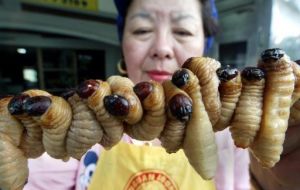MercoPress. South Atlantic News Agency
FAO suggests farming and feeding on insects can address global food insecurity
 Dr. Eva Muller, insects are not harmful to eat; they are nutritious and even a delicacy
Dr. Eva Muller, insects are not harmful to eat; they are nutritious and even a delicacy While insects can be slimy, cringe-inducing creatures, often squashed on sight by humans, a new book released by the Food and Agricultural Organization (FAO) says beetles, wasps and caterpillars are also an unexplored nutrition source that can help address global food insecurity.
The book, Edible Insects: future prospects for food and feed security, stresses not just the nutritional value of insects, but also the benefits that insect farming could potentially have on the environment and on addressing the rapidly increasing demand for food worldwide.
While the idea of eating a worm, grasshopper or cicada at every meal may seem strange, FAO says this has many health benefits. Insects are high in protein, fat and mineral contents. They can be eaten whole or ground into a powder or paste, and incorporated into other foods.
“Insects are not harmful to eat, quite the contrary: they are nutritious, they have a lot of protein and are considered a delicacy in many countries” said Eva Muller, the Director of FAO Forest Economics, Policy and Products Division.
Although they are not staples of Western cuisine, insects currently supplement the diets of some 2 billion people and have always been part of human diets in Asia, Africa and Latin America. Of the 1 million known insect species, 1900 are consumed by humans. Some of the most consumed insects include beetles, caterpillars, bees, wasps, ants, grasshoppers, locusts and crickets.
“If we think about edible insects, there’s a huge potential that has essentially not been tapped yet,” Ms. Muller said. “Most [insects] are just collected and there’s very little experience in insect farming, for example, which is something that could be explored in view of a growing population.”
According to the book, which was launched today at the Forests for Food Security and Nutrition conference, taking place through Wednesday at FAO headquarters in Rome, farming insects for human and animal consumption is particularly relevant at a time when population growth, urbanization, and the rising middle class have increased the demand for food while simultaneously harming the environment that enables its production.
By 2030, over 9 billion people will need to be fed, along with the billions of animals raised annually for food and as pets. Meanwhile, land and water pollution from intensive livestock production and over-grazing are leading to forest degradation, thereby contributing to climate change.
“Domesticating and rearing insects can help sustain insect populations while also helping counter nutritional insecurity and improve livelihoods,” said Afton Halloran, a consultant for the FAO Edible Insects Program. “Farming insects has a huge global potential for both animal feed and food production. We are already seeing producers creating animal feed from insects and research. And development is occurring around the world in order incorporate insects into menus and processed foods.”
The production of greenhouse gases by insect farming would likely be lower than that of livestock. For example, pigs produce 10-100 times more greenhouse gases per kilogram than mealworms.
Insects also feed on bio-waste, use significantly less water than livestock, and can be farmed more easily, the book states. Insect farming could also offer important livelihoods to people in rural areas as minimal technical or capital expenditure is required for basic harvesting and rearing equipment.
Their high nutritional value and relative ease of en-masse production will not be enough to make insects part of people’s dishes all over the world, and FAO knows this.
“Consumer disgust remains one of the largest barriers to the adoption of insects as viable sources of protein in many Western countries,” Ms. Muller said in an interview. “Nevertheless, history has shown that dietary patterns can change quickly, particularly in the globalized world.”
She added that Western countries, most notably in Europe, have also been recently expressing interest in incorporating insects into their cuisine.





Top Comments
Disclaimer & comment rules-

-

-

Read all commentsThe UN continues to be alarmist in its population projections. There's a slow consensus building that even their low variant is perhaps too high.
May 14th, 2013 - 07:58 am 0Their low variant supposes a population of 7.85 billion in 2030 not 9 billion.
And going further 6.2 billion at 2100.
And that is now considered HIGH!
Sausage and caterpillars! Beetles on toast! Gin and wasp! Nope, don't think so.
May 14th, 2013 - 12:04 pm 0I am very happy to let all the members and employees of the Food and Agricultural Organization (FAO) to eat as many beetles, wasps and caterpillars as they like, just don't expect the rest of us to do the same.
May 14th, 2013 - 06:54 pm 0Commenting for this story is now closed.
If you have a Facebook account, become a fan and comment on our Facebook Page!